Views: 92
我絕對有信心令初次接觸意大利酒的人喜歡上 Brunello。Barolo 也不難,只要放一點 Giacosa、一點 Bartolo,再不然請出 Monfortino來,眾人哪有不下跪之理?
但 Chianti 卻困難重重!
偶然在報章雜誌讀到專家的文章,常見大半篇幅像法律文件一樣,把 DOCG、DOC、IGT 和 Super Tuscan等一大堆名詞巨細無遺的解釋得清清楚楚,但讀者卻越看越糊塗。這時候,我覺得律師真的不及判官那麼高明。有位近年大紅大紫的亞洲 MW 分析意大利酒為何在意大利餐廳的銷售也及不上法國酒時,寫下了鏗鏘有力的一字判詞﹕Confusing,所以應判死刑。
可惜賣意大利酒的人也高明不了多少。常聽銷售員跟滿臉疑惑的客人解釋說﹕意大利酒的特色是酸度特高,最好用來配番茄意大利麵或薄餅。
Confusing 也好,配番茄意大利麵也好,這些都不應該是Brunello和Barolo的罪,追究起來,原兇其實是 Chianti!
但我偏要為 Chianti 說話,所以兩年前我不自量力,一共寫了五篇介紹Chianti的文章,還特別找來近 100 瓶 Chianti,天天喝,月月喝,我悟出來的簡單道理是﹕
Tuscany近代的酒藝復興,簡單地說是一場與Ricasoli的對話,而且這場對話今天仍然在進行中。
(見前文﹕漫步 Chianti (之五)﹕The First Bloom of Sangiovese )
這場酒藝復興運動發生在 Chianti,也就是500多年前那場文藝復興的同一發源地﹕Florence 與 Siena 之間的地帶。
上星期,我鼓足勇氣,帶了以下6件呈堂證物,請了我的 VIPa 團友做陪審員,我想他們告訴我 Chianti 能登大雅之堂嗎?Chianti 有資格與 Giacosa 和 Monfortino 一起稱為 The Greatest Italians 嗎?
6 瓶中的 4 瓶被入選為 Decanter 的 18 大之一,1 與 4 是我選的。
| 1. Castello di Monsanto, Chianti Classico Riserva Il Poggio, 1977 (my selection) |
| 2. Montevertine, Le Pergole Torte, 1983 |
| 3. Isole e Olena, Cepparello, 1985 |
| 4. Castellare di Castellina,I Sodi di San Niccolo, 1985 (my selection) |
| 5. Antinori, Tignanello, 1988 |
| 6. Felsina, Chianti Classico Riserva Rancia, 1990 |
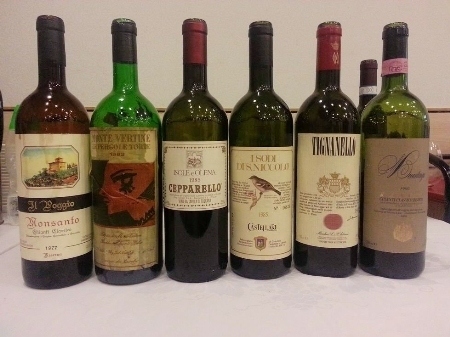
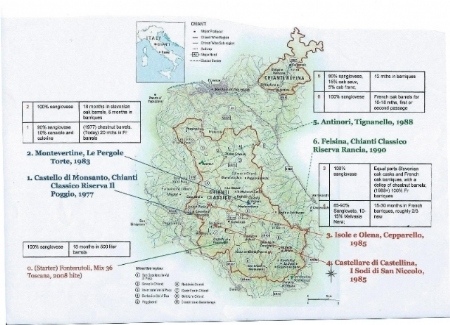
跟以往的習慣一樣,我們一共有 6 款酒,分 3 雙各進行兩回合的品試。
所有酒在早上 8 時開瓶,兩個小時後小試,之後一直在原瓶呼吸,到下午 5 時(即 9 個小時後)把瓶塞放回,然後坐計程車約 15 分鐘抵達餐廳。品試為時 3 個多小時。
第一場﹕1977 Monsanto Il Poggiovs1983 Le Pergole Torte
Montevertine 的 Le Pergole Torte 今天可能是最有名的 Chianti,但 20 年前,Monsanto 的名氣恐怕要大得多,其中一個原因可能是他們出道比較早。
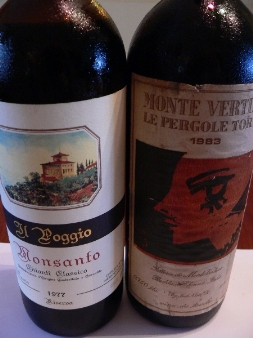
Sergio Manetti 在 1967 年買下 Montevertine 所在地,第二年開始在名為 Le Pergole Torte 的葡萄園種植 Sangiovese,1977年才試產。
Monsanto 在 1961 年買下莊園時,佃農早已在那裏種植葡萄和釀酒了,所以 Monsanto 在 1977 年已經有老樹可以依靠。Sheldon Wasserman 在 1985 年判定他們是 Chianti 第一﹕
It is in our considerable experience without question the single finest Chianti and one of the world’s vinicultural treasures.
Nicolas Belfrage 四份一個世紀後認為如果有一天 Tuscany 仿照 Burgundy 那樣按田分級,則 Il Poggio 肯定是 Grand Cru 的首選。
但我們的陪審員恐怕都沒聽過這些掌故,我甚至不肯定他們以前是否兩款酒都嘗過,所以審判是公正的。
第一回合的比試由 Le Pergole Torte 以 6 比 4 勝出,這是合理的結果。喜歡 Le Pergole Torte 的說他細緻,取 Il Poggio 的讚他複雜。
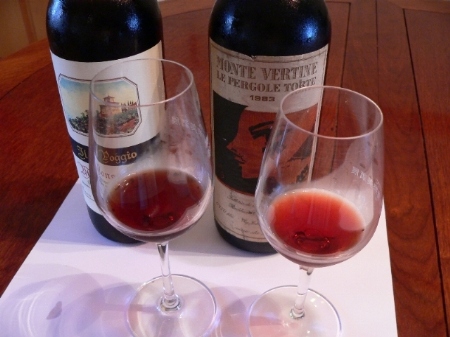
早上小試時,Le Pergole Torte 有很輕盈、優雅的香氣﹕泥土的、蘑菇、沉香;入口清新、平衡、漂亮的酸度,一副美人的胚子。Il Poggio 帶一點醬油和煙絲的氣味,有豐富的果味,酸度和平衡度也出色,體格強大,但穩重。
晚上第一回合的 Le Pergole Torte 更多了樹皮和意大利媽媽燒菜的醬汁香氣(蘑菇、番茄、陳醋),又帶點香粉,依然迷人,很 tertiary。Il Poggio 比早上更濃更厚,有些濃茶、黑巧克力的味道,很好的回甘甜味,早上的醬油氣味大部分散掉了,明顯地比 Le Pergole Torte 複雜,但這時淑女似乎比君子更討好。
第二回合的 Il Poggio 卻出奇地以 9 比 1 反勝 Le Pergole Torte,大家一致被 Il Poggio 的驚人大變身嚇壞了,他的酒體多了一種黏黏的質感,令我想起 Il Paradiso di Manfredi 莊主開的一瓶 1983,Florio 說酒體像 balsamic honey!有趣的是這回合唯一投給 Le Pergole Torte 的一位原來也是選 Il Poggio 的,不過待酒都喝完了以後他始終念念不忘 Le Pergole Torte,他說「公仔頭」跳躍、細膩、新鮮、年青,所以要求回到 Le Pergole Torte 的懷抱。
結果兩個回合合算,由 Il Poggio 以 13 票勝 Le Pergole Torte 的 7 票。
Il Poggio 勝在愈戰愈勇,Le Pergole Torte 則吃虧在沒有進一步發展,甚至在第二回合有一點點倒退。
我懷疑這裏既有意外也有意料中的因素。
意外的是酒的保存狀態與及樹齡。
兩瓶酒的保存狀態以 Monsanto 較好,是直接從酒莊出來的,瓶塞結實;Montevertine 的瓶塞比較軟,而且有些小洞。看酒色,Monsanto 比較深,帶棕色,酒液有點混濁不清;Montevertine 可漂亮了,如紅寶石發亮的顏色,較淺,憑外觀他可能比 Monsanto 發展得更快,也就是說實際年齡更老。
上面說過 Monsanto 入主時已有老樹,所以老樹應該令酒更 Il Poggio 複雜。
但我懷疑 terroir 的因素更大。
Monsanto 與 Montevertine 處於 Chianti 西與東兩個山頭,其中 Montevertine 地勢較高,而且面北與東北,所以葡萄不會太熟,個性飄逸多於複雜;Monsanto 的土地帶給他古典的性格,結構與果味兼備。
因此,不斷變身和老而彌堅的 Il Poggio 踫上優雅但弱不禁風的 Le Pergole Torte,較多人選勇士棄黛玉,這本非怪事。但我敢打賭,過了幾個月以後,必定會有人步 M 兄後塵,回心轉意重投 Le Pergole Torte 的懷抱。我猜我太太是第一個,我可能是第二。
第二場﹕1985 Isole e Olena Cepparello vs 1985 Castellare di Castellina, I Sodi di San Niccolo
這一場的結果太懸殊了。
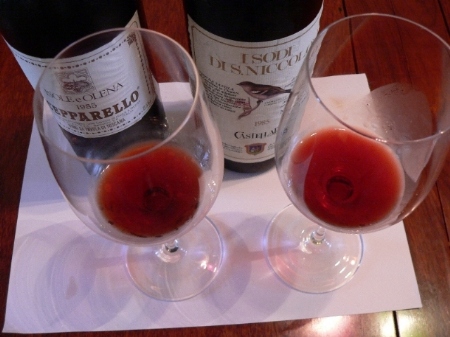
Cepparello 在第一回合全拿 10 分,第二回合才讓回 3 分給 I Sodi di San Niccolo,所以 Cepparello 以總分 17 比 3 大勝。
早上小試時我還有點為 Cepparello 擔心呢!他的瓶塞非常堅實,可是有點醬油氣味,雖然這也難掩一股很地道的紅櫻桃和甜甜的香氣。中度酒體,有驚人的平衡度和酸度,幾乎像老僧入定一樣,平靜、和諧,大概到了生命最美妙的一刻,sweet spot 是也。
I Sodi di San Niccolo 很乾淨,如果不是一些松露、蘑菇的氣味,感覺仍然很 primary,比 Cepparello 起碼年青 10 年。很完整的口感,甚麼都有,果味比較突出,真的很 primary,就像我兩年半以前的一瓶一樣,充分表現了 1985 的和暖性格。
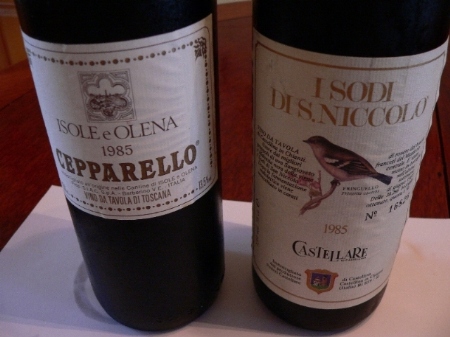
1985 Cepparello 是很禪意的酒,是一種頓悟的經驗,他的好是當下即是的好,而不是他有甚麼 —你的心已經與他融為一體,不用靠腦子來分析他有甚麼。
1985 I Sodi di San Niccolo 卻令你拼命去找他﹕果味、丹寧、酸度有嗎?夠嗎?平衡嗎?他給你的是知性的滿足,就如年輕人,聰明但欠智慧。
晚上的第一回合,Cepparello 仍然平衡優雅,醬油氣味仍在,但已不算強烈。I Sodi di San Niccolo 比上午稍為開放了一些,但仍然以較 primary 的果味為主,所以有人嫌他太簡單。
到了第二回合,Cepparello 好像午睡醒來,氣味更濃烈了,大家開始熱烈地評論他的醬油氣味,但似乎稱讚的居多!醬油氣味可能是氧化的徵兆,較嚴重的時候變成所謂的「十全大補酒」,但今天欣賞的人居多,有人說現在的醬油味很香,已經融合成為酒的一部分了,像蒸魚用的頭抽!我想起一個月以前的一瓶 1985 Soldera 也以這種怪異的香氣傾倒眾生。
有了這種新發展,我覺得 Cepparello 少了一點飄逸,不過仍然非常平衡好喝。這一刻,瘦削、斯文、謙虛、永遠帶著一絲微笑的 Paolo De Marchi 的身影又出現了。團友認為 Cepparello 是醬油與 Sangiovese 的美妙結合,我卻認為他是 Paolo 與 Sangiovese 渾然一體的結合,Cepparello 唱著的是純樸的 Barberino Val d’Elsa 山歌!猶記得去年末 Paolo 來香港主持酒宴時,他的第一句話是﹕I don’t make a wine for the market, but one that is true to the soil. 微斯人,吾誰與歸?
在迷醉於 Cepparello 的風雅的同時,我們發現這時的 I Sodi di San Niccolo 也變得更開放了,平衡度也變好了,但與 Cepparello 比,總是欠了些成熟的韻味,不過敗在 Cepparello 的手下,又怎能不服氣?而且看來 I Sodi di San Niccolo 仍處於待變的狀態,我們要記著莫欺少年窮!
Castellare di Castellina 位於 Castellina,是 Isole e Olena 所在地 Barberino Val d’Elsa 稍南的鄰村,位置是蠻接近的,莊主也叫 Paolo(Panerai),與 De Marchi 都從1970年代末開始皈依 Sangiovese,但兩款酒的性格卻差異頗大,究竟是因為葡萄的成份不同(I Sodi di San Niccolo 混兌了 15% Malvasia Nera 之多,而 Cepparello 是純 Sangiovese),還是當年的 Cepparello 大小木桶並用(I Sodi di San Niccolo用法國小木桶)所致,我目前說不清楚,但如果我們拿這兩兄弟與 Brunelloc比較,當發現 Chianti 相對早熟,而且更早達致平衡與和諧,像小家碧玉多於公主貴胄。Sangiovese 在 Chianti 顯露了更樸實,但同樣迷人的性格。如果你跟我一樣認為意大利菜的精髓在於家常菜(home style cooking)而不是 Otto e Mezzo 那種較注重擺設的宴會菜,你便明白為何 Chianti 在我心裏的地位比 Brunello 還要高一線。
第三場﹕1988 Antinori Tignanello vs 1990 Felsina Rancia
很意外的是,我們一路過來看到的平衡與和諧突然被這一南一北的莽漢打破了。
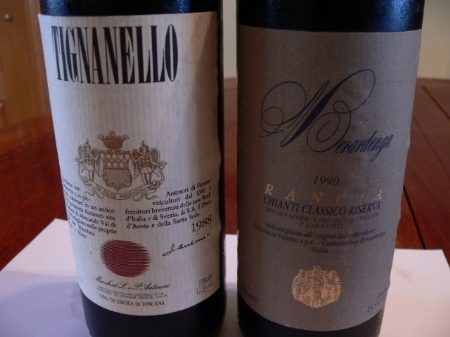
主要問題出在 Tignanello。
一位團員很風趣的說Tignanello 給他的感覺像聽洋妞講粵語,很別扭。比較客氣的一位說他太簡單,只有甜味,不客氣的一位更說他是個三不像。
所以第一回合的投票由 Rancia 以 8 比 1 輕易勝出。
但投票給 Tignanello 的陪審員並非愛聽洋人講廣東話,他的意見是 Rancia 一言不發,所以無從下判斷。
另一位卻為了同樣原因投棄權票﹕他既不喜歡 Tignanello,但也沒聽到 Rancia 的證詞。
到了第二回合,除了一票棄權以外,陪審團更一致裁定 Tignanello 不及格。
問題出在 Tignanello 的 20% 國際葡萄和小木桶。Cabernet Sauvignon太霸道了,連 10% 也會讓嬌嫩的 Sangiovese 面目模糊,何況他用上了 15% Cabernet Sauvignon 和 5% Cabernet Franc?他既失去 Sangiovese 的優雅,也沒有了Cabernet Sauvignon 的力量。他的法國木桶味也太重了,像 Bordeaux 一樣,越老的 Tignanello 越像皺紋那樣突出,所以請記住一點﹕選 Chianti,第一要問他除了 Sangiovese 以外還有甚麼葡萄?
Felsina 的莊主 Giuseppe Mazzocolin 對 Cabernet Sauvignon 沒有歧見,他除了Sangiovese 以外還製作了一瓶名叫 Maestro Raro 的純 Cabernet Sauvignon,他的意見很值得參考﹕
Cabernet is a great grape variety in its own arena, as is Merlot, but it has got no business in Chianti, nor being blended with Sangiovese. Even with 2 percent Cabernet, one cannot have the experience of pure Sangiovese, whose greatest character lies in its evolution in bottle.
他甚至說﹕
We should shout this from the rooftops that if you’re going to add these grapes, you’d be better off going back to Trebbiano!
[見 Nicolas Belfrage專著作的 Felsina介紹]
公道的說,在普遍不那麼認真種植 Sangiovese 的年代,加點 Cabernet Sauvignon 不一定比加白葡萄更壞(雖然 Giuseppe Mazzocolin 認為他寧可用 Trebbiano 白葡萄也不用 Cabernet),就如同病人被迫要吃有副作用的西藥一樣。但四份之一個世紀過後,尤其是 Chianti Classico 2000 計劃在 1988 年啟動以來,Sangiovese 已經遍地開花了,Decanter 讓 Tignanello 拿個歷史貢獻勛章是無可厚非的,但老調依然重彈,而且愛酒人還要為了一點法國味而多付一兩倍的鈔票,值得嗎?
不過我更關心的是 1990 Rancia。
我看出來大家因為不喜歡 Tignanello 而被迫投 Rancia 的票,但對 Rancia 實在看不透,究其原因是 Rancia 可能是 Chianti 最慢熱的酒。我過去喝過從 1990 到2006 的年份,沒有一次嘗過比較開放的 Rancia。
所以在第二回合,我決定用兩只酒杯來回的「換瓶」,希望加快他的發展。果不然,悶葫蘆終於開口了,果味、酸度、丹寧開始清晰地列隊接受檢閱,太陽從雲端探頭出來了!
但這是苦候了大半天的結果。
早上小試時,我的筆記是﹕
Brooding nose of animals or soya sauce (?), some dark cherries. Taste is big and concentrated, like sitting on a big blanket but it does not feel heavy at all. Tannins aplenty but well integrated. Needs time.
我決定下次開Rancia時要試用處理年青 Barolo 的 partial double decanting 方法。
但把這個巨人這樣打發走是不公平的。我永遠記得 Antonio Galloni 曾這樣描述莊主 Giuseppe Mazzocolin﹕
If you were to cut proprietor Giuseppe Mazzocolin’s veins the man would bleed Sangiovese, such is his passion forTuscany’s most important native grape.
所以我要為他多說兩句。
Antonio Galloni 去年進行了多次 Chianti 名酒的垂直品試,他高度稱讚了1990 Rancia,並打了97分之高,評語是﹕
Still quite young, the 1990 doesn’t seem to have developed the full range of its tertiary complexity. The tannins are pure silk, the fruit is radiant and everything is in the right place. This isn’t a huge or opulent 1990 as so many wines are in this vintage. Rather is a wine built on the heights of finesse and grace. Today the 1990 is a showstopper.
他的結論是﹕It is easily one of the greatest wines ever made in Tuscany.
Tuscany歷來最偉大的酒?!?
Nicolas Belfrage在酒莊從最早的 1983 試到c2001,還包括了果味較豐富也更討好的兄弟 Fontalloro,他的結論是 1990 Rancia 是最好的一瓶!讓我引他的評語﹕
The apotheosis of the Rancia style: complex, truffle-pate nose and savory palate, with beautifully balanced acid/tannin structure.
Joseph Bastianich 的怪論更為Rancia抹上了一層神秘色彩﹕
For first-time tasters, Rancia generally comes as a surprise. This is not a strong, powerful wine, but a rather lean, austere product with the edgy, tart acidity that only sangiovese can produce … If tasted carelessly, this wine may fool you, especially the older vintages. Don’t be surprised if after five or six years, Rancia tastes older than its age; this is normal. The wine evolves precociously but then stops. It almost crystallizes after six years and then continues to age very, very slowly. After ten years, it is surprisingly still full of life.
聽起來像 Biondi Santi 的 Chianti 版本!
就讓我們的陪審團帶著這個疑問結束這場審判吧!
Wine of the Night
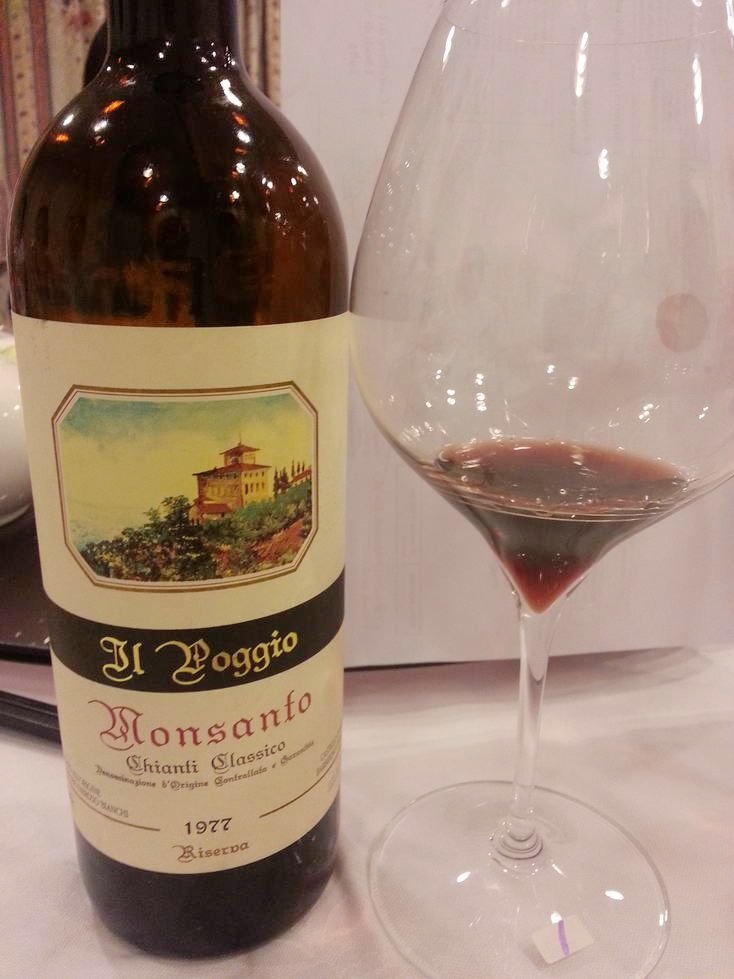
1977 Monsanto 在第二回合大反攻打敗了 1983 Le Pergole Torte 以後,更以 6/10 高分數成為今天的 WOTN!
我心中的大熱 1985 Cepparello 以2 ½分屈居第二,1985 I Sodi di San Niccolo和 1983 Le Pergole Torte以1分和½分當殿軍。
但真正的勝利者應該是 Chianti。經此一役,我知道起碼有 10 個人不會視 Chianti 為二等公民。
我這次考試也總算過關了吧?
意大利的三大精品酒 Barolo/Barbaresco、Brunello 和 Chianti 的導賞團到此也宣告完滿結束了。我們下次的「畢業旅行」會尋幽探勝,尋找 The Other Italy。
再見!
後記
對 Chianti 有興趣的讀者,可以馬上出發參加下面的五天遊﹕
漫步 Chianti (之一): The Renaissance of Sangiovese
漫步 Chianti (之二): The Magic of Le Pergole Torte
漫步 Chianti (之五)﹕The First Bloom of Sangiovese
Thanks for the great tasting notes.
Are there any recommended wine glasses for Sangiovese?
Or Chianti and Brunello shall use different glasses?
Thanks a lot.
Last week I tried a 2004 Felsina Rancia. Decanter suggested the drinking window is from 2009 to 2022. Yet even with 10 hours’ breath in the bottle, the wine was still not opened at all.
Borrowing Burgundy, Sangiovese can vary from Borgogne to Grand Cru level, so it is not easy to say what glass is the best. But Brunello often needs a wider mouth glass to reveal its full aromas.
Rancia is one of the slowest developers. If you want to force it open, you can perhaps treat it as a Barolo, i.e. use the partial double decanting method that I have often advocated for young Barolos. I would guess the same thing is true about most Soldera’s, and Baricci.